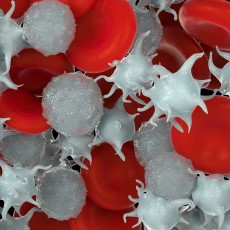
Platelets, also known as thrombocytes, are blood cells. They form in your bone marrow, a sponge-like tissue in your bones. Platelets play a major role in blood clotting. Normally, when one of your blood vessels is injured, you start to bleed. Your platelets will clot (clump together) to plug the hole in the blood vessel and stop the bleeding. You can have different problems with your platelets:
- If your blood has a low number of platelets, it is called thrombocytopenia. This can put you at risk for mild to serious bleeding. The bleeding could be external or internal. There can be various causes. If the problem is mild, you may not need treatment. For more serious cases, you may need medicines or blood or platelet transfusions.
- If your blood has too many platelets, you may have a higher risk of blood clots.
- When the cause is unknown, this is called thrombocythemia. It is rare. You may not need treatment if there are no signs or symptoms. In other cases, people who have it may need treatment with medicines or procedures.
- If another disease or condition is causing the high platelet count, it is thrombocytosis. The treatment and outlook for thrombocytosis depends on what is causing it.
- Another possible problem is that your platelets do not work as they should. For example, in von Willebrand Disease, your platelets cannot stick together or cannot attach to blood vessel walls. This can cause excessive bleeding. There are different types of in von Willebrand Disease; treatment depends on which type you have.
NIH: National Heart, Lung, and Blood Institute
- Platelet Disorders (National Library of Medicine)Platelets, also known as thrombocytes, are blood cells. They form in your bone marrow, a sponge-like tissue in your bones. Platelets play a major ...
- ... measure how many platelets you have in your blood. Platelets are particles in the blood that help the ...
- Platelet Disorders/Clinical Trials ... Platelet Disorders ... National Institutes of Health ... From the National Institutes of Health
- Blood Basics (American Society of Hematology)Blood/Start Here ... Blood ... Glossary of common hematology terms. ... American Society of Hematology
- ... What are platelet tests? Platelets, also known as thrombocytes, are small blood cells that are essential for ... provide more reliable results. Other names: platelet count, thrombocyte count, platelet function tests, platelet function assay, platelet ...
- AML Guide: Information for Patients and Caregivers (Leukemia & Lymphoma Society) - PDFAcute Myeloid Leukemia/Start Here ... Acute Myeloid Leukemia ... Leukemia & Lymphoma Society ... PDF
- Signs and Symptoms of Childhood Leukemia (American Cancer Society)Childhood leukemia may cause certain signs and symptoms. Learn what to watch for here. ... Childhood Leukemia/Symptoms ... Childhood Leukemia ... American Cancer Society
- Hematology Glossary (American Society of Hematology)Blood Disorders/Reference Desk ... Blood Disorders ... Bleeding/Reference Desk ... Bleeding ... Blood/Reference Desk ... Blood ... Hematology Glossary ... American Society of Hematology
- Multiple Myeloma: Patient Handbook (International Myeloma Foundation) - PDFMultiple Myeloma/Start Here ... Multiple Myeloma ... International Myeloma Foundation ... PDF
- Understanding Leukemia (Leukemia & Lymphoma Society) - PDFLeukemia/Start Here ... Leukemia ... Leukemia & Lymphoma Society ... PDF



